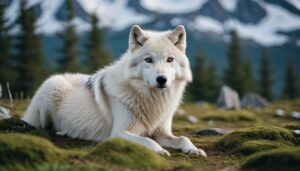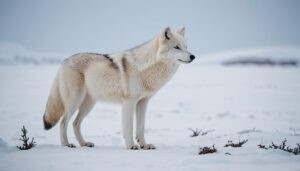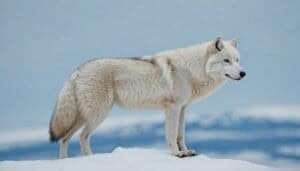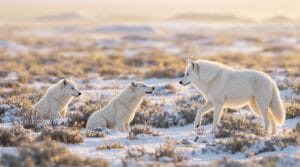Introduction
Arctic wolves play a vital role in maintaining the delicate balance of their ecosystem
This article explores their prey and hunting techniques, their ecological impact, the Arctic habitat and its species, the social structures and adaptations of wolf packs, and the threats they face
Additionally, we will examine their contributions to biodiversity, highlighting how these remarkable predators help sustain the Arctic environment
Arctic Wolf Prey and Hunting Techniques
Arctic wolves, also known as white wolves or polar wolves, have adapted remarkably well to their harsh environment. Their diet and hunting strategies are key components of their survival and play a significant role in maintaining the balance of their ecosystem
Common Prey Species
The primary prey of Arctic wolves includes muskoxen, Arctic hares, caribou, lemmings, and various species of birds. During the summer months, when prey is more abundant, Arctic wolves often hunt in smaller packs or even alone. In winter, when food is scarcer, they rely on larger packs to take down bigger prey like muskoxen and caribou:
Muskoxen: These large, formidable animals are a staple in the diet of Arctic wolves. Hunting muskoxen requires cooperation among pack members, as these prey animals are both strong and well-defended by their thick fur and horns
Arctic Hares: These smaller mammals are more accessible and require less cooperative hunting efforts. They are a crucial food source, especially during the months when larger prey is scarce
Caribou: Migratory caribou provide a seasonal bounty for Arctic wolves. The wolves often follow caribou herds, taking advantage of their migratory patterns to hunt
Lemmings and Birds: While not as significant as muskoxen or caribou, these smaller prey animals supplement the diet of Arctic wolves, particularly for lone wolves or smaller packs
Hunting Techniques
Arctic wolves exhibit a range of hunting techniques that reflect their adaptability and intelligence. Their hunting strategies are finely tuned to their prey and the challenging environment of the Arctic:
Pack Hunting: When targeting large prey such as muskoxen or caribou, Arctic wolves rely on coordinated pack hunting strategies. They use teamwork to isolate and exhaust their prey, often targeting the young, old, or weak members of a herd. This method ensures a higher success rate and minimizes the risk to individual wolves
Ambush Hunting: For smaller prey like Arctic hares or birds, wolves often use ambush tactics. They rely on their white fur to blend into the snowy environment, allowing them to approach their prey stealthily. A sudden burst of speed and agility then secures their meal
Endurance Hunting: Arctic wolves are known for their stamina. They can pursue prey over long distances, using their endurance to outlast and eventually capture their targets. This technique is particularly effective in the vast, open expanses of the tundra where cover is minimal
Solo Hunting: While pack hunting is common, solo hunting is also a vital skill. Lone wolves or those hunting smaller prey need to rely on their individual prowess. They utilize stealth, patience, and sudden speed to capture their targets
Ecological Impact of Arctic Wolves
Arctic wolves are not just predators but vital components of their ecosystem, contributing to the balance and health of the Arctic environment. Their presence significantly influences predator-prey dynamics, population control, and the overall vegetation of their habitat
Predator-Prey Dynamics
Arctic wolves play a critical role in maintaining the balance between predator and prey populations. Their hunting activities directly affect the population sizes of their prey species, which in turn influences the entire ecosystem:
Regulating Prey Populations: By preying on species like muskoxen, Arctic hares, and caribou, Arctic wolves help keep these populations in check. This regulation prevents overpopulation, which can lead to overgrazing and depletion of vegetation
Healthy prey populations contribute to the overall stability of the ecosystem
Promoting Genetic Health: Wolves typically target the weakest, sickest, or youngest members of a herd. This selective predation helps ensure that only the fittest individuals survive and reproduce, promoting the genetic health and resilience of prey populations
This natural selection process helps maintain robust and adaptable prey species
Balancing Species Interactions: The presence of Arctic wolves can influence the behavior and distribution of other species in the ecosystem
For instance, their hunting pressure can cause prey species to alter their grazing patterns, leading to a more even distribution of vegetation and reducing the risk of overgrazing in specific areas
Population Control
Arctic wolves are crucial for controlling the populations of their prey, ensuring that no single species dominates the ecosystem to the detriment of others:
Preventing Overgrazing: Without predators like wolves, herbivore populations could grow unchecked, leading to overgrazing
Overgrazing can severely damage vegetation, resulting in soil erosion and loss of habitat for other species. By keeping herbivore numbers in balance, Arctic wolves help preserve the integrity of the tundra’s plant life
Supporting Biodiversity: A balanced ecosystem with controlled prey populations supports a wide range of species. The presence of wolves helps create a more diverse and resilient environment
Other predators, scavengers, and smaller animals benefit from the ecological stability provided by a balanced predator-prey dynamic
Influence on Vegetation
The indirect effects of Arctic wolves on vegetation are profound. By regulating herbivore populations, they help maintain healthy plant communities, which in turn support a variety of other species:
Vegetation Recovery: In areas where wolves are present, vegetation tends to recover more quickly from grazing
This recovery is due to the reduced grazing pressure on plants, allowing them to grow and reproduce. Healthier plant communities provide food and habitat for other animals, promoting overall biodiversity
Nutrient Cycling: Wolves also contribute to nutrient cycling in the ecosystem. The remains of their prey provide nutrients for scavengers and decomposers, which in turn enrich the soil. This nutrient cycling supports plant growth and sustains the food web
Indirect Plant Protection: The presence of wolves can lead to changes in the behavior of herbivores
For example, in areas where wolves are actively hunting, herbivores may avoid certain regions, allowing vegetation in those areas to flourish. This creates a mosaic of plant life with varying levels of grazing pressure, contributing to the ecological diversity of the tundra
Arctic Habitat and Coexisting Species
The Arctic habitat, a unique and harsh environment, is home to a diverse array of species that coexist with Arctic wolves. Understanding this habitat and the species within it is crucial to appreciating the role that Arctic wolves play in their ecosystem
Arctic Habitat Overview
The Arctic tundra is characterized by its extreme cold, strong winds, and a landscape dominated by ice and snow for most of the year. Despite these challenging conditions, the tundra supports a surprisingly rich and diverse range of life:
Climate and Geography: The Arctic tundra experiences long, harsh winters and short, cool summers. The ground remains frozen for most of the year, with a surface layer that thaws briefly during the summer months
This thawing allows a burst of plant growth, which in turn supports the herbivores and, subsequently, the predators like Arctic wolves
Vegetation: The tundra’s vegetation consists mainly of low-lying plants such as mosses, lichens, grasses, and dwarf shrubs. These plants are adapted to withstand the cold and often grow in dense mats to conserve heat
The brief summer growing season is crucial for these plants to photosynthesize and reproduce
Water Sources: Freshwater sources in the tundra are limited to melting snow and ice during the summer. These temporary water sources are vital for all the inhabitants of the tundra, including Arctic wolves and their prey
Other Species in the Ecosystem
The Arctic tundra is home to a variety of species that have adapted to its harsh conditions. These species coexist with Arctic wolves, creating a complex web of interactions and dependencies:
Herbivores: The primary prey of Arctic wolves, herbivores like caribou, muskoxen, and Arctic hares are well-adapted to the tundra environment
Caribou migrate long distances in search of food, while muskoxen are more stationary, forming defensive circles to protect themselves from predators. Arctic hares rely on their white fur for camouflage and are a critical food source for wolves, especially in winter
Birds: Many bird species migrate to the Arctic during the summer to breed
Species such as snowy owls, Arctic terns, and various species of geese and ducks rely on the brief abundance of food and nesting sites. These birds also fall prey to Arctic wolves and other predators
Small Mammals: Lemmings and voles are abundant in the tundra and form a significant part of the diet for many predators, including Arctic foxes and snowy owls. Their population cycles can influence the abundance and hunting success of these predators
Other Predators: Arctic wolves share their habitat with other predators, including polar bears, Arctic foxes, and snowy owls
While each species has its niche, there is competition for food, particularly during the lean winter months
Invertebrates: Despite the cold, a variety of invertebrates such as insects and spiders thrive in the tundra. These invertebrates are crucial for nutrient cycling and serve as food for many bird species
Social Structures and Adaptations of Wolf Packs
Arctic wolves have developed intricate social structures and remarkable adaptations that enable them to survive and thrive in the harsh conditions of the Arctic tundra. Their social behavior and physical characteristics are key to their success as apex predators in this extreme environment
Pack Hierarchy
Arctic wolves live in packs that typically consist of a family unit led by an alpha pair. The pack’s social structure is essential for cooperative hunting, rearing young, and defending territory:
Alpha Pair: The alpha male and female are the dominant leaders of the pack. They are usually the only breeding pair within the pack, and their leadership is crucial for maintaining order and coordinating hunting efforts
The alpha pair makes decisions for the group, such as when to hunt and where to establish den sites
Beta Wolves: The beta wolves are second in command and support the alpha pair. They help in maintaining discipline within the pack and may take over leadership roles if something happens to the alpha pair
Subordinate Wolves: These wolves are typically younger or lower-ranking adults. They follow the lead of the alphas and betas, contributing to hunting and pack activities
Subordinate wolves play vital roles in the pack, assisting in caring for pups and participating in cooperative hunting
Pups: The young members of the pack, pups are born in the spring and are heavily dependent on the entire pack for survival. All pack members help raise the pups, providing food and protection
Pack Cooperation and Hunting
Cooperative hunting is one of the most critical aspects of Arctic wolf pack behavior. By working together, they can take down larger prey that would be impossible for a single wolf to tackle alone:
Coordinated Strategies: Arctic wolves use a variety of hunting strategies that require close cooperation and communication. They may surround a herd of caribou, isolating a vulnerable individual and using their numbers to wear it down
This teamwork increases their hunting success and ensures that the entire pack is fed
Role Specialization: Within the pack, wolves may take on specific roles during a hunt. Some wolves act as chasers, driving the prey towards other pack members who are waiting to ambush
Others may act as blockers, preventing the prey from escaping. This role specialization enhances their efficiency and effectiveness as hunters
Food Sharing: After a successful hunt, food sharing is a vital part of pack dynamics
The alpha pair usually eats first, followed by other adult pack members and finally the pups. This hierarchy ensures that the strongest and most crucial members of the pack are well-nourished, maintaining the pack’s overall health and strength
Physical and Behavioral Adaptations
Arctic wolves possess a range of physical and behavioral adaptations that enable them to endure the extreme conditions of the Arctic:
Thick Fur: One of the most notable physical adaptations of Arctic wolves is their thick, insulating fur. This dense coat provides essential warmth during the frigid Arctic winters
The fur is white, which offers excellent camouflage against the snow, aiding in both hunting and avoiding detection by other predators
Compact Body Size: Compared to other wolf species, Arctic wolves have a more compact body size, which helps minimize heat loss
Their shorter ears, legs, and muzzle are adaptations to reduce the surface area exposed to the cold
Foot Structure: Arctic wolves have large, padded feet that distribute their weight more evenly on the snow, preventing them from sinking. This adaptation is particularly useful when hunting or traveling across the snowy landscape
Behavioral Adaptations: Behavioral adaptations are equally crucial for survival. Arctic wolves are known for their endurance and ability to travel long distances in search of food
They are also highly social animals, relying on pack cooperation for hunting, rearing young, and protecting their territory
Denning Behavior: During the harshest winter months, Arctic wolves dig dens in the snow or find shelter in caves. These dens provide protection from the extreme cold and a safe place to raise their pups
Threats and Contributions to Biodiversity
Arctic wolves, while well-adapted to their environment, face several threats that jeopardize their survival. Despite these challenges, they contribute significantly to the biodiversity and ecological health of the Arctic tundra
Climate Change Impact
Climate change poses one of the most severe threats to Arctic wolves and their habitat. The warming climate leads to numerous changes in the Arctic environment, affecting the wolves directly and indirectly:
Melting Ice and Snow: The rising temperatures result in the melting of ice and snow, which reduces the habitat available for Arctic wolves and their prey
This habitat loss forces wolves to travel greater distances in search of food, increasing their energy expenditure and reducing their chances of survival
Altered Prey Patterns: Climate change affects the migration patterns and population dynamics of prey species. For instance, caribou may change their migratory routes or timing, making it harder for wolves to predict and follow their movements
This disruption can lead to food shortages and impact the overall health of wolf packs
Vegetation Changes: As the Arctic warms, the composition of vegetation changes. The encroachment of shrubs and trees into the tundra can alter the habitat and food sources available to herbivores, subsequently affecting the wolves that depend on these herbivores for food
Human Activities
Human activities also pose significant threats to Arctic wolves, even in the remote and relatively pristine Arctic regions:
Oil and Gas Exploration: The exploration and extraction of oil and gas in the Arctic lead to habitat destruction and fragmentation
The infrastructure development associated with these activities disrupts the natural landscape and can lead to direct conflicts between wolves and humans
Pollution: Industrial activities and increased shipping traffic in the Arctic contribute to pollution, which can have detrimental effects on wildlife
Contaminants can accumulate in the food chain, impacting the health of both prey and predator species, including Arctic wolves
Climate-Induced Human Encroachment: As climate change makes the Arctic more accessible, increased human presence brings additional threats such as hunting and disturbance of natural habitats. This encroachment further pressures Arctic wolves and other wildlife
Maintaining Ecological Balance
Despite these challenges, Arctic wolves play a crucial role in maintaining the ecological balance of their habitat. Their presence and activities have far-reaching effects on the Arctic ecosystem:
Predator-Prey Dynamics: By controlling the populations of their prey, Arctic wolves help maintain a balanced ecosystem
This regulation prevents overpopulation of herbivores, which can lead to overgrazing and degradation of vegetation. A healthy balance between predator and prey ensures the sustainability of the tundra environment
Supporting Vegetation Health: Through their impact on prey species, wolves indirectly support the health of vegetation
Controlled herbivore populations reduce grazing pressure, allowing plant communities to thrive. This vegetation, in turn, supports a diverse array of other species
Nutrient Cycling: Arctic wolves contribute to nutrient cycling by providing food for scavengers and decomposers
The remains of their prey enrich the soil, supporting plant growth and sustaining the food web. This nutrient cycling is vital for the productivity and resilience of the tundra ecosystem
Supporting Various Species
The presence of Arctic wolves also supports the biodiversity of the Arctic by influencing the distribution and behavior of other species:
Creating Opportunities for Scavengers: Animals like Arctic foxes, ravens, and various scavenger birds benefit from the kills made by wolves
These scavengers rely on the leftovers from wolf hunts for their survival, highlighting the interconnectedness of the Arctic food web
Promoting Species Diversity: By maintaining the balance of prey populations and supporting vegetation health, Arctic wolves contribute to a diverse and stable ecosystem. This diversity enhances the resilience of the Arctic environment, making it better able to withstand environmental changes and pressures
Conclusion
Arctic wolves are keystone species in their ecosystem, significantly influencing the balance and health of the Arctic tundra. Their role as apex predators impacts prey populations, vegetation, and other species, maintaining a delicate equilibrium essential for biodiversity
Arctic wolves primarily hunt muskoxen, Arctic hares, and caribou, using a variety of coordinated strategies to ensure their survival. Their hunting not only sustains their packs but also regulates prey populations, preventing overgrazing and promoting plant health. This balance supports a diverse array of species, highlighting the wolves’ indirect but vital role in nutrient cycling and ecosystem stability
The social structure of Arctic wolf packs, with its clear hierarchy and cooperative hunting tactics, exemplifies their adaptability and intelligence. Their physical and behavioral adaptations, such as thick fur and compact bodies, enable them to thrive in one of the harshest climates on Earth
However, Arctic wolves face significant threats from climate change and human activities. Melting ice and altered prey patterns, along with habitat disruption from oil and gas exploration, pose serious challenges to their survival
Despite these threats, the wolves continue to play a crucial role in maintaining the ecological balance of the tundra
Their presence supports various species, from scavengers that feed on leftover kills to plant communities that benefit from controlled herbivore populations. By fostering a balanced and diverse ecosystem, Arctic wolves contribute to the overall resilience of the Arctic environment
In conclusion, the role of Arctic wolves in their ecosystem is multifaceted and vital. Protecting these magnificent creatures and their habitat is essential for preserving the intricate web of life in the Arctic tundra
The conservation of Arctic wolves ensures the continued health and stability of this unique and fragile ecosystem, benefiting countless species and maintaining the natural balance of one of the world’s most extreme environments











